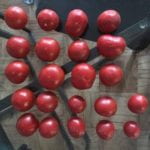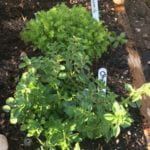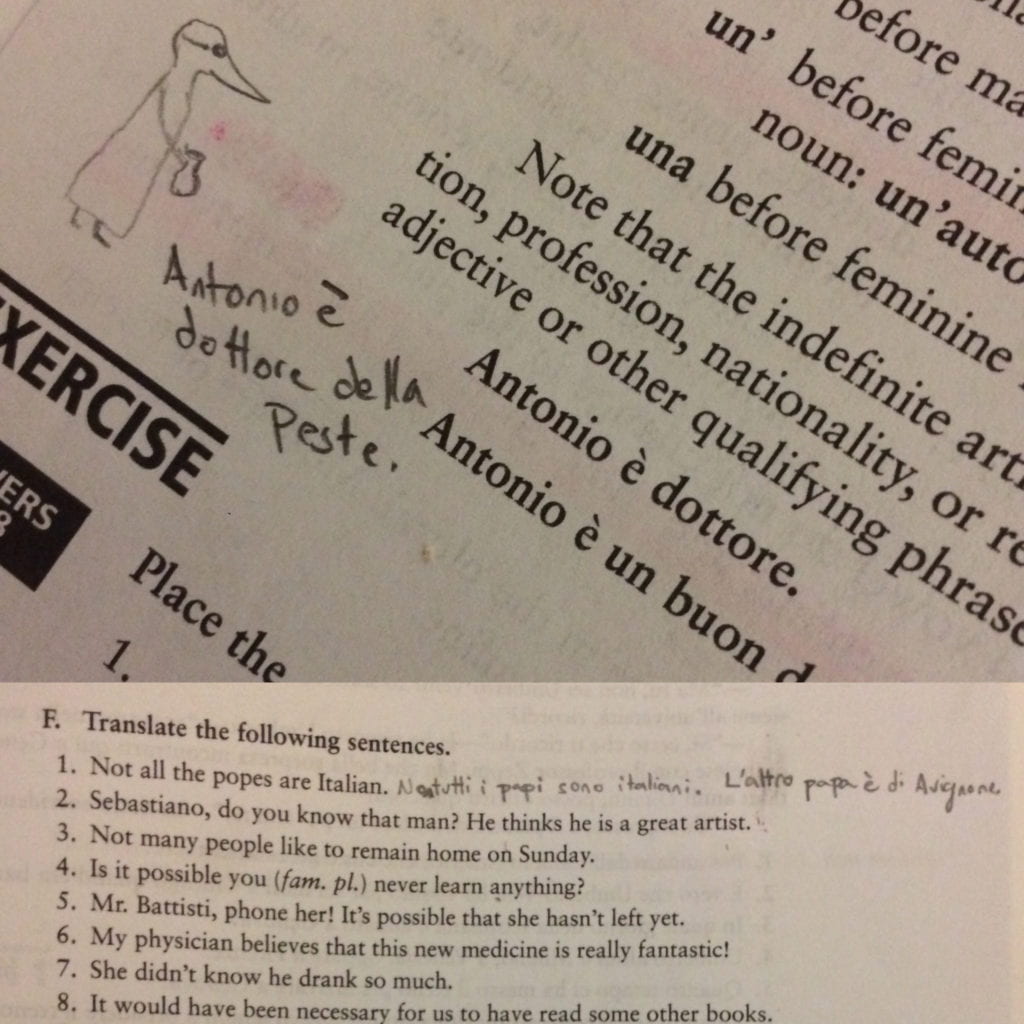1) I’m just gathering some very preliminary thoughts for now. This will eventually be an essay of a sort.
2) Yes, I’m supposed to be learning Russian and procrastinating by learning Italian instead.
3) I can read Italian just fine. I have Spanish and Latin and that’s enough to fake my way through. I had to read a metric tonne of Italian archaeological reports for my general exams in grad school (late Byzantine and early Islamic fortifications in the Hadramawt). I got pretty good pretty quick with all that practice. I want to be able to do more with it that read about moats and mud.
4) Reading (and to a certain but lesser extent, aural) comprehension was never going to be the problem. Slowing myself down enough to practice generating all the forms is. It’s hard to stick to changing definite articles from the singular to the plural or writing out three-word sentences with a choice of two verbs that you can conjugate in the simple present when you can flip to the back of the book and understand perfectly well the two-page passage on Pompeii.
5) Italian really is a completely different language from Spanish. I’m not sure why I was expecting it to be otherwise having read lots of it, but it was both a surprise and a relief to realize this when I opened my DIY Italian book. I was worried that all that there would be to it would be a series of small modifications to Spanish that I’d infinitely mix up, never learn properly, and confuse my Spanish horribly, to boot. Instead, it’s something that I have to learn from the ground up and having Spanish ends up being nothing but a huge help as a similar-but-distinct point of reference.
6) Italian is a diglossic language and standard Italian is as much a living linguistic fiction as Modern Standard Arabic. Even for learning an easy language, I’ve managed to pick a complicated one.
7) It’s the summer so this isn’t playing out in a classroom, but I think that with the very limited way in which I can express myself in Italian, I’m beginning to feel more empathy with my students. My undergraduates already have a pretty good level of Spanish by the time they get to me — I teach literature and history of the language, not elementary languages classes. But even though they have a decent-sized vocabulary and a handle on the subjunctive, their Spanish still isn’t anywhere close to their English (with the exception of those students who are native Spanish speakers). It never really occurred to me before now because they can express complex thoughts in a variety of verbal modes and times; but even so, they must be thinking so much more than they can say. And that’s super frustrating.
8) I’m using two books. One is a workbook meant for people who want to learn Italian on their own and the other is a textbook meant for use in a college-level beginning Italian class (and in spite of whatever Amazon’s algorithm has done in the interim, I paid less than 5% of the current $645.12 asking price). The textbook is, well, my same vintage, which is to say that it’s definitely from the era in which there were no bundled media files that came with the book and accompanying YouTube channels for language classes. So it very much assumes that you will be hearing a professor speaking and repeating after him/her or responding to prompts. As a workaround, when it’s important to hear the pronunciation of new words I have been typing them into Google Translate and using the little audio feature to hear them read aloud. So I may end up speaking Italian with a Google accent. 
9) There’s this quip that the vocabulary in the first chapter of a language textbook tells you what’s important in the culture(s) and place(s) where the language is spoke. Playing to type, the vocabulary for the first chapter of the DIY book is all food. It’s great because the summer produce is in at the farmers’ market and my community garden and I can kind of practice the basics in a seasonal way. So, you know, ho ventidue pomodori. And also, ci sono le herbe aromatiche. The trouble is that at this point all I have is four irregular verbs in the present tense a

 nd not a lot of context for place except in un ristorante del centro. I’m finding that my brain is filling in the gaps in Arabic: i peperoni sono fī l-jannah. On the one hand, it’s super unhelpful, but on the other hand it’s kind of an interesting insight into how the brain stores and processes foreign languages.
nd not a lot of context for place except in un ristorante del centro. I’m finding that my brain is filling in the gaps in Arabic: i peperoni sono fī l-jannah. On the one hand, it’s super unhelpful, but on the other hand it’s kind of an interesting insight into how the brain stores and processes foreign languages.
10) Don’t leave medievalists alone learning Italian. We have a weird sense of humor.






 nd not a lot of context for place except in un ristorante del centro. I’m finding that my brain is filling in the gaps in Arabic: i peperoni sono fī l-jannah. On the one hand, it’s super unhelpful, but on the other hand it’s kind of an interesting insight into how the brain stores and processes foreign languages.
nd not a lot of context for place except in un ristorante del centro. I’m finding that my brain is filling in the gaps in Arabic: i peperoni sono fī l-jannah. On the one hand, it’s super unhelpful, but on the other hand it’s kind of an interesting insight into how the brain stores and processes foreign languages.